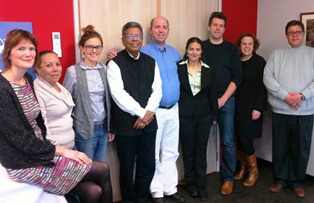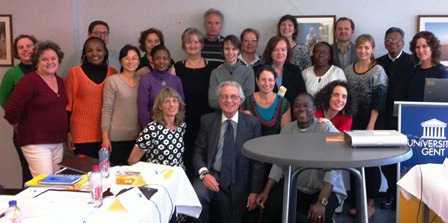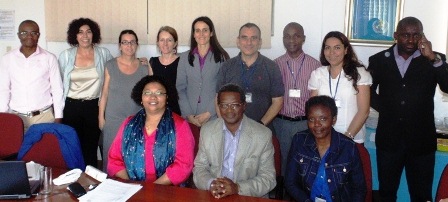Newsletter January 2015
 ICRH Global Newsletter ICRH Global Newsletter 28th of January, 2015
|
| PROJECTS |
Adolescents in Latin America
The FP7-funded intervention research project ‘Community-Embedded Reproductive Health Care for Adolescents in Latin America’ (CERCA) aimed to improve global knowledge about how health systems could be more responsive to the changing sexual and reproductive health (SRH) needs of adolescents. Implemented by Latin American and European research institutes, CERCA tested community-embedded interventions to improve adolescent communication with parents, partners and peers on SRH issues; access to accurate SRH information; use of SRH services in primary health settings; and use of modern contraceptives. While the intervention did have some positive effect (on condom use and overall knowledge and use of sexual health services in Ecuador, on ease of communication in Bolivia), these did not live up to the expectations. On the other hand, among project management and other people involved in the intervention there is a not to be neglected feeling, amongst others based on the results of qualitative research, that the effectiveness of the interventions is larger than what was measured quantitatively. With funding from the department of Reproductive Health and Research of the World Health Organization, the consortium has been doing a very valuable post-hoc process evaluation over the past few months. During a consortium meeting in Ghent 8-10 December 2014, the participants reflected upon the data collected, performed joint analyses and drew common conclusions on the strengths and weaknesses in the CERCA project development, implementation and evaluation. More information: Kristien Michielsen, kristien.michielsen@ugent.be |
| Global Early Adolescent Study in Ecuador FWO and SENESCyT finance a joint project of ICRH and the Faculty of Medicine of the University of Cuenca, and adds Ecuador as a site to the GEAS study Within the scope of a bilateral research cooperation, FWO (Research Fund – Flanders) and SENESCyT (Secretaría Nacional de Educación Superior, Ciencia, Tecnología e Innovación) will finance a research collaboration between ICRH and the Faculty of Medicine of the University of Cuenca in Ecuador. Both institutions will work closely together to implement the Global Early Adolescent Study (GEAS) in the city of Cuenca, Ecuador. Adolescent sexual and reproductive health (ASRH) is a major public health concern. Ecuador has the highest rates of adolescent pregnancy in the Andean region. The overall objective of this study is to contribute to ASRH in Ecuador. During the 2 years’ period of the project, we will study how gender norms are formed among young adolescents in Cuenca (in depth interviews), contribute to developing instruments to measure gender norms and ASRH in early adolescence (EA), study the associations between gender norms and EA SRH (cross-sectional survey) and develop recommendations for policies and interventions. More information: Sara De Meyer, saraa.demeyer@ugent.be |
Global Early Adolescent Study
The Global Early Adolescent Study (GEAS) aims to understand the factors in early adolescence that predispose young people to subsequent sexual health risks and conversely that contribute to healthy sexuality so as to provide the information needed to improve sexual and reproductive health outcomes. GEAS is led by Johns Hopkins School of Public Health (Baltimore, USA) and the Department of Reproductive Health and Research of the World Health Organization. The study is implemented in fourteen countries. Researchers of the different study sites met in Ghent early December and had lively discussions for two days on the development of instruments to measure gender norms and attitudes among early adolescents as well as to assess their health. On the third day, the GEAS Advisory Board members, representing leadership from WHO, UNFPA, UNICEF, UNESCO, Packard Foundation, Plan International and researchers from leading Universities including the University of Amsterdam and Oxford, joined the group to reflect on past activities and advise the investigators on how to move forward. More information: Sara De Meyer, saraa.demeyer@ugent.be |
Steering Committee Meeting of the WHO ANC study in Mozambique
The purpose of the meeting was to review progress in the trial and also to bring together various stakeholders to start to discuss the potential implications of the trial on policy development in Mozambique. Participants included WHO-Geneva, WHO-Mozambique, the Mozambique Ministry of Health, ICRH-Mozambique, the Mozambique representation of the Government of Flanders, as well as other local stakeholders. This study is testing an intervention to improve the quality of antenatal care in Mozambique, consisting mainly of the provision of “ANC Kits” containing all medicines, tests and other supplies needed to carry out the WHO-defined evidence-based interventions that have been adopted by Mozambique, as well as the introduction of a “one-stop” patient-centered ANC service for pregnant women. The study design is a stepped-wedge cluster randomized control trial, involving 10 health centers across the country, with one health center starting to receive the intervention every two months. To date the intervention has been launched in 4 sites since implementation started in June 2014, and the study will run until February 2016. More information: Sally Griffin, icrh.coord@tdm.co.mz |
| EVENTS |
Marleen Temmerman fund
The ‘Marleen Temmerman Fund’ was established by Ghent University in honor of ICRH-founding mother prof. Marleen Temmerman and to raise funds for ICRH projects. The new website includes among others information on how to donate and invites visitors to register for the Fund’s newsletter. Visit the website at www.marleentemmermanfund.org. |
| ICRH PEOPLE |
Lotte De Schrijver and Luk Van Baelen Lotte De Schrijver and Luk Van Baelen joined the ICRH-team to work on the project ‘Towards a better estimation of prevalence of female genital mutilation in the European Union’ (FGM-PREV). This DAPHNE-funded project aims to provide a common definition of FGM prevalence and to develop a common methodology to estimate the prevalence of FGM in the EU.
|
Málica de Melo Málica de Melo has joined ICRH Mozambique as Program Manager (Maternal & Child Health) at ICRH Mozambique. This role includes overseeing ICRH’s programs in this area as well as contributing to the development of new ones, and coordinating the MOMI project in Mozambique. Málica has over seven years of experience working with NGOs in the area of sexual and reproductive health and child protection in Mozambique, during which time she has developed expertise particularly in the areas of program management, monitoring and evaluation and research. She is currently undertaking a Masters in Public Health at the Eduardo Mondlane university in Maputo. More information: Málica de Melo, icrh.research@tdm.co.mz |
Aurore Guieu
Aurore’s first contact with ICRH was through her internship within the framework of her studies at SciencesPo Paris, France, in the spring of 2012. A few months later, after having graduated, she returned to ICRH to do a literature review on migrants and sexual and reproductive health, and after that she worked on several projects, including MOMI and DIFFER. From February 2015 on, Aurore will work as an advocacy officer for International Planned Parenthood Federation – European Network (IPPF EN). More information: aguieu@ippfen.org |
Wim Delva
The group, led by Professor Sebastian Bonhoeffer, uses a combination of mathematical and computational models to investigate the dynamics and evolution of infectious diseases. Its close collaboration with the Swiss HIV Cohort Study ensures that their models are data-driven, and inform clinical management of HIV and public health decisions. During his sabbatical, Wim will conduct a statistical analysis of the time-trends in HIV testing behaviors, ART initiation and HIV viral load distribution over the past decade among MSM populations in Switzerland. In addition, he will expand the Simpact modeling framework, such that it is able to generate simulated HIV transmission networks among MSM populations, as well as simulated phylogenetic trees that are directly derived from (complex) samples from these transmission networks. With this expanded version of Simpact, we will have a powerful framework to investigate how the expansion in ART coverage and acceleration in ART initiation has impacted on the transmission dynamics among the MSM population in Switzerland. While this project is based on data from Switzerland, it opens the door to subsequent analyses of data from MSM populations in Belgium and other Western European countries. This sabbatical is in part funded by the Research Foundation - Flanders (FWO) and the National Research Foundation (NRF) of South Africa. More information: wim.delva@ugent.be |
| PUBLICATIONS |
Women's empowerment and contraceptive use in Pakistan The role of independent versus couples' decision-making, from a lower middle income country perspective. There is little available evidence of associations between the various dimensions of women's empowerment and contraceptive use having been examined--and of how these associations are mediated by women's socio-economic and demographic statuses. The authors assessed these phenomena in Pakistan using a structured-framework approach. They analyzed data on 2,133 women who were either using any form of contraceptive or living with unmet need for contraception. The survey was conducted during May - June 2012, with married women of reproductive age (15-49 years) in three districts of Punjab. The dimensions of empowerment were categorized broadly into: economic decision-making, household decision-making, and women's mobility. Two measures were created for each dimension, and for the overall empowerment: women's independent decisions, and those taken jointly by couples. Contraceptive use was categorized as either female-only or couple methods on the basis of whether a method requires the awareness of, or some support and cooperation from, the husband. Multinomial regression was used, by means of Odds Ratios (OR), to assess associations between empowerment dimensions and female-only and couple contraceptive methods. Overall, women tend to get higher decision-making power with increased age, higher literacy, a greater number of children, or being in a household that has superior socio-economic status. The measures for couples' decision-making for overall empowerment and for each dimension of it showed positive associations with couple methods as well as with female-only methods. The only exception was the measure of economic empowerment, which was associated only with the couple method. The authors conclude that couples' joint decision-making is a stronger determinant of the use of contraceptive methods than women-only decision-making. This is the case over and above the contribution of women's socio-demographic and economic statuses. Effort needs to be made to educate women and their husbands equally, with particular focus on highly effective contraceptive methods. Hameed W, Azmat SK, Ali M, Sheikh MI, Abbas G, Temmerman M, Avan BI. Women's empowerment and contraceptive use: the role of independent versus couples' decision-making, from a lower middle income country perspective. PLoS One. 2014 Aug 13;9(8):e104633. doi: 10.1371/journal.pone.0104633. eCollection 2014. |
Global causes of maternal death A WHO systematic analysis of global, regional, and subregional estimates of the causes of maternal death during 2003-09, with a novel method. The authors searched specialized and general bibliographic databases for articles published between Jan 1, 2003, and Dec 31, 2012, for research data, with no language restrictions, and the WHO mortality database for vital registration data. On the basis of prespecified inclusion criteria, causes of maternal death were analyzed from datasets, and country level estimates were aggregated to report estimates of causes of death by Millennium Development Goal for regions and worldwide, and for main and subcauses of death categories. The authors identified 23 eligible studies and included 417 datasets from 115 countries comprising 60?799 deaths in the analysis. About 73% of all maternal deaths between 2003 and 2009 were due to direct obstetric causes and deaths due to indirect causes accounted for 27·5% of all deaths. Hemorrhage accounted for 27·1%, hypertensive disorders 14·0%, and sepsis 10·7% of maternal deaths. The rest of deaths were due to abortion (7·9%), embolism (3·2%), and all other direct causes of death (9·6%). Regional estimates varied substantially. The authors conclude that Between 2003 and 2009, hemorrhage, hypertensive disorders, and sepsis were responsible for more than half of maternal deaths worldwide. More than a quarter of deaths were attributable to indirect causes. These analyses should inform the prioritization of health policies, programs, and funding to reduce maternal deaths at regional and global levels. Further efforts are needed to improve the availability and quality of data related to maternal mortality. Say L, Chou D, Gemmill A, Tunçalp Ö, Moller AB, Daniels J, Gülmezoglu AM, Temmerman M, Alkema L. Global causes of maternal death: a WHO systematic analysis. Lancet Glob Health. 2014 Jun;2(6):e323-33. doi: 10.1016/S2214-109X(14)70227-X. Epub 2014 May 5. |
Female genital mutilation and Flemish midwives Results of the first female genital mutilation (FGM) knowledge, attitude and practices study among of Flemish midwives. 820 midwives, actively working in labor wards, maternity wards and maternal intensive care units were surveyed with semi-structured questionnaires. More than 15% of the respondents were recently confronted with FGM. They were mostly faced with the psychological and sexual complications caused by FGM. Few respondents were aware of existing guidelines regarding FGM in their hospitals (3.5%). The results also showed that only 20.2% was aware of the exact content of the law. The majority of midwives condemned the harmful traditional practice: FGM was experienced as a form of violence against women or a violation of human rights. Only 25.9% declared that FGM forms a part of their midwifery program. The vast majority of respondents (92.5%) indicated a need for more information on the subject. The authors conclude that there is an important need for appropriate training of (student)midwives concerning FGM as well as for the development and dissemination of clear guidelines in Flemish hospitals. Cappon Sien, L’Ecluse Charlotte, Clays Els, Tency Inge, Leye Els. Female genital mutilation: Knowledge, attitude and practices of Flemish midwives. Midwifery (2015), http://dx.doi.org/10.1016/j.midw.2014.11.012. |
Maternal and perinatal health research priorities beyond 2015 An international survey and prioritization exercise. Maternal mortality has declined by nearly half since 1990, but over a quarter million women still die every year of causes related to pregnancy and childbirth. Maternal-health related targets are falling short of the 2015 Millennium Development Goals and a post-2015 Development Agenda is emerging. In connection with this, setting global research priorities for the next decade is now required. The authors adapted the methods of the Child Health and Nutrition Research Initiative (CHNRI) to identify and set global research priorities for maternal and perinatal health for the period 2015 to 2025. Priority research questions were received from various international stakeholders constituting a large reference group, and consolidated into a final list of research questions by a technical working group. Questions on this list were then scored by the reference working group according to five independent and equally weighted criteria. Normalized research priority scores (NRPS) were calculated, and research priority questions were ranked accordingly. A list of 190 priority research questions for improving maternal and perinatal health was scored by 140 stakeholders. Most priority research questions (89%) were concerned with the evaluation of implementation and delivery of existing interventions, with research subthemes frequently concerned with training and/or awareness interventions (11%), and access to interventions and/or services (14%). Twenty-one questions (11%) involved the discovery of new interventions or technologies. The authors conclude that the resulting ranked list of research questions provides a valuable resource for health research investors, researchers and other stakeholders, and are hopeful that this exercise will inform the post-2015 Development Agenda and assist donors, research-policy decision makers and researchers to invest in research that will ultimately make the most significant difference in the lives of mothers and babies. Souza JP, Widmer M, Gülmezoglu AM, Lawrie TA, Adejuyigbe EA, Carroli G, Crowther C, Currie SM, Dowswell T, Hofmeyr J, Lavender T, Lawn J, Mader S, Martinez FE, Mugerwa K, Qureshi Z, Silvestre MA, Soltani H, Torloni MR, Tsigas EZ, Vowles Z, Ouedraogo L, Serruya S, Al-Raiby J, Awin N, Obara H, Mathai M, Bahl R, Martines J, Ganatra B, Phillips SJ, Johnson BR, Vogel JP, Oladapo OT, Temmerman M. Maternal and perinatal health research priorities beyond 2015: an international survey and prioritization exercise. Reprod Health. 2014 Aug 7;11:61. doi: 10.1186/1742-4755-11-61. |
Pregnancy and war A comparison of pregnancy outcomes in Benghazi, Libya, before and during the armed conflict in 2011. Issues des grossesses à Benghazi (Libye) avant et pendant le conflit armé de 2011. Les femmes enceintes qui vivent des événements stressants peuvent être plus à risque d’une issue obstétricale défavorable. L’étude menée à Benghazi a comparé les taux de prématurité, de faible poids de naissance et de césarienne à l’hôpital Al-Jamhouria dans les mois précédant et pendant le conflit armé en Libye en 2011. Les données recueillies auprès de toutes les femmes admises en salle d’accouchement entre février et mai 2011 (au plus fort des combats dans la ville) (n = 7096), et entre octobre et décembre 2010 (les mois précédant la guerre) (n = 5935). Par rapport aux mois précédents, une augmentation importante du taux d’accouchements impliquant une prématurité (3,6 % contre 2,5 %) et un faible poids de naissance (10,1 % contre 8,5 %) ainsi que des césariennes (26,9 % contre 25,3 %) a été observée pendant le conflit. Le stress psychosocial peut avoir été un facteur (entre autres) dans l’augmentation des issues négatives de la grossesse, et les établissements obstétricaux devraient être informés de ces problèmes en temps de guerre. Stressful life events experienced by pregnant women may lead to adverse obstetric outcomes. This study in Benghazi compared the rates of preterm, low-birth-weight and caesarean-section births at Al-Jamhouria hospital in the months before and during the armed conflict in Libya in 2011. Data were collected on all women admitted to the delivery ward during February to May 2011 (the months of the most active fighting in the city) (n = 7096), and October to December 2010 (the months immediately before the war) (n = 5935). Compared with the preceding months there was a significant rise during the conflict in the rate of deliveries involving preterm (3.6% versus 2.5%) and low-birth-weight (10.1% versus 8.5%) infants and caesarean sections (26.9% versus 25.3%). Psychosocial stress may have been a factor (among others) in an increase in negative pregnancy outcomes, and obstetric hospitals should be aware of these issues in times of war. Bodalal Z, Agnaeber K, Nagelkerke N, Stirling B, Temmerman M, Degomme O. Pregnancy outcomes in Benghazi, Libya, before and during the armed conflict in 2011. East Mediterr Health J. 2014 Apr 3;20(3):175-80. |
Sexual behaviors among adolescents in Nicaragua A study aimed at gaining insight into factors that determine sexual onset and contraceptive use among adolescents from poor neighborhoods in Managua. From July until August 2011, a door-to-door survey was conducted among adolescents living in randomly selected poor neighborhoods of Managua. Logistic regression was used to analyze factors related to sexual onset and contraceptive use. Data from 2803 adolescents were analyzed. Of the 475 and 299 sexually active boys and girls, 43% and 54%, respectively, reported contraceptive use. Sexual onset was positively related to increasing age, male sex, alcohol consumption and not living with the parents. Catholic boys and boys never feeling peer pressure to have sexual intercourse were more likely to report consistent condom use. Having a partner and feeling comfortable talking about sexuality with the partner were associated with hormonal contraception. The data identified associates of adolescents ’ sexual behavior related to personal characteristics (sex and alcohol use), to the interaction with significant others (parents, partners, peers) and to the environment (housing condition, religion). The authors interpreted those associates within the context of the rapidly changing society and the recently implemented health system reform in Nicaragua. Peter Decat, Sara De Meyer, Lina Jaruseviciene, Miguel Orozco, Marcia Ibarra, Zoyla Segura, Joel Medina, Bernardo Vega, Kristien Michielsen, Marleen Temmerman and Olivier Degomme. Sexual onset and contraceptive use among adolescents from poor neighbourhoods in Managua, Nicaragua. The European Journal of Contraception and Reproductive Health Care, 2014; Early Online: 1–13. |
Contraceptive options for women living with HIV. Women living with HIV are often of reproductive age, and many desire effective contraceptive options to delay or prevent pregnancy. The authors reviewed the safety of various hormonal and non-hormonal contraceptive methods for women living with human immunodeficiency virus (HIV). Additionally, they discuss drug interactions between contraceptive methods and antiretrovirals and the safety of methods with respect to onward transmission to HIV-negative partners for women in sero-discordant partnerships. In general, most methods are safe for most women living with HIV. An understanding of the reproductive goals of each individual patient, as well as her medical condition and medication, should be taken into account when counseling women on their contraceptive options. Further research is needed to understand drug interactions between contraceptives and antiretrovirals better and how to fulfill the contraceptive needs of HIV-positive women. Phillips S, Steyn P, Temmerman M. Contraceptive options for women living with HIV. Best Pract Res Clin Obstet Gynaecol. 2014 Aug;28(6):881-90. doi: 0.1016/j.bpobgyn.2014.04.013. Epub 2014 May 9. |
It's about time WHO and partners release programming strategies for postpartum family planning. The postpartum period is a critical time to address high unmet family planning need and to reduce the risks of closely spaced pregnancies. Practical tools are included in the new resource for integrating postpartum family planning at points when women have frequent health system contact, including during antenatal care, labor and delivery, postnatal care, immunization, and child health care. Gaffield ME, Egan S, Temmerman M. It's about time: WHO and partners release programming strategies for postpartum family planning. Glob Health Sci Pract. 2014 4;2(1):4-9. doi: 10.9745/GHSP-D-13-00156. eCollection 2014. |


 Follow-up study of the project ‘Community-Embedded Reproductive Health Care for Adolescents in Latin America’ (CERCA).
Follow-up study of the project ‘Community-Embedded Reproductive Health Care for Adolescents in Latin America’ (CERCA). An investigators and Advisory Board Meeting was held on 1-3 December 2014 in Gent, Belgium.
An investigators and Advisory Board Meeting was held on 1-3 December 2014 in Gent, Belgium. The annual Steering Committee meeting for the WHO study ‘Implementation of Evidence-Based Antenatal Care in Mozambique: A Randomized Control Trial’ took place in Maputo on 17-18 November 2014.
The annual Steering Committee meeting for the WHO study ‘Implementation of Evidence-Based Antenatal Care in Mozambique: A Randomized Control Trial’ took place in Maputo on 17-18 November 2014. 
 Lotte De Schrijver has a Master degree in Human Sexuality Studies, a Master degree in World Religions, Inter-religious Dialogue and Religious Studies and a Master degree in Clinical and Health Psychology. Currently she follows two trainings to become a psycho-oncologist and a cognitive behavioral therapist. Lotte combines her work at the ICRH with a private practice as a clinical psychologist-sexologist, she works in Kliniek Sint-Jan Brussel as a psychologist on the oncology department and is a board member of the Vlaamse Vereniging van Klinisch Psychologen (Flemish Association of Clinical Psychologists).
Lotte De Schrijver has a Master degree in Human Sexuality Studies, a Master degree in World Religions, Inter-religious Dialogue and Religious Studies and a Master degree in Clinical and Health Psychology. Currently she follows two trainings to become a psycho-oncologist and a cognitive behavioral therapist. Lotte combines her work at the ICRH with a private practice as a clinical psychologist-sexologist, she works in Kliniek Sint-Jan Brussel as a psychologist on the oncology department and is a board member of the Vlaamse Vereniging van Klinisch Psychologen (Flemish Association of Clinical Psychologists). After having worked for ICRH for almost three years, Aurore is taking up a job at the IPPF office in Brussels.
After having worked for ICRH for almost three years, Aurore is taking up a job at the IPPF office in Brussels.